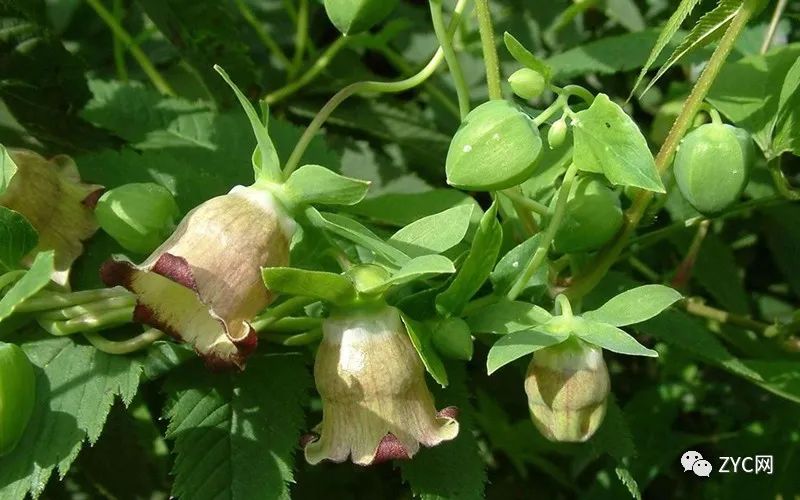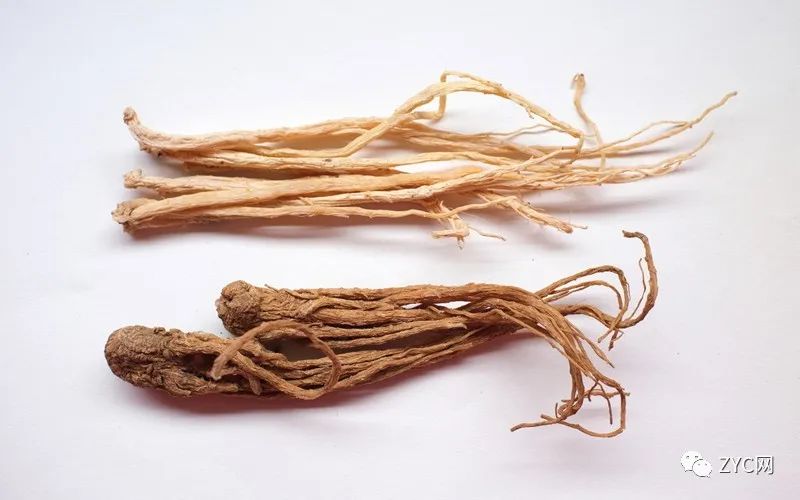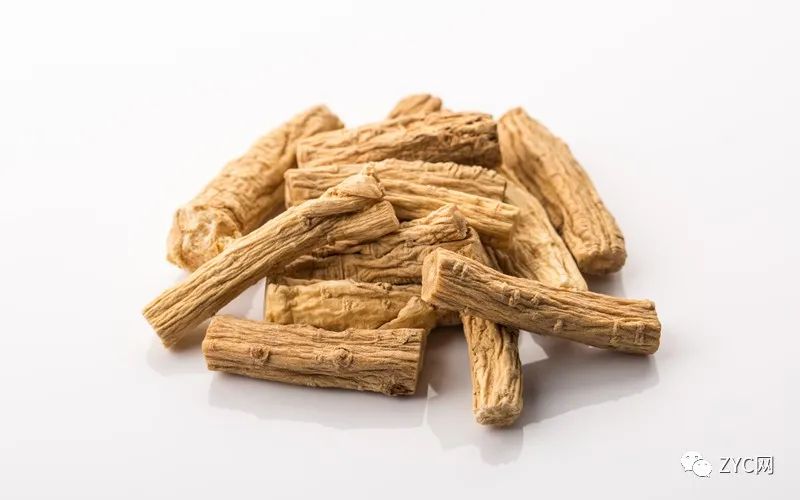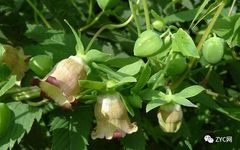“Codonopsis, known in Traditional Chinese Medicine (TCM) as Dang Shen. Other names include: Shangdang Ginseng, Fangfeng Dang Shen, Huang Shen, Fang Dang Shen, Shangdang Shen, Lion’s Head Ginseng, and Zhongling Grass. It is the root of the plant Codonopsis pilosula (Franch.) Nannf., belonging to the Campanulaceae family, or the root of Codonopsis tangshen Oliv. It is known for its ability to tonify the spleen and lungs, generate fluids, and nourish the blood. It is primarily used to treat conditions such as spleen and stomach deficiency, lung deficiency with cough and wheezing, fluid damage leading to thirst, and blood deficiency with weakness.
Properties and Channels
Sweet in flavor, neutral in nature; it enters the spleen and lung channels.

01
—
Efficacy and Functions
Functions
Tonifies the spleen and benefits the lungs, generates fluids, and nourishes the blood.
Indications
1. Primarily used for spleen and stomach deficiency, lung deficiency with cough and wheezing, fluid damage leading to thirst, and blood deficiency with weakness.
2. In Western medicine, it is indicated for conditions such as gastroptosis, nephroptosis, rectal prolapse, uterine prolapse, chronic gastroenteritis associated with spleen and stomach deficiency, bronchitis, upper respiratory infections associated with lung qi deficiency, diabetes associated with qi and yin deficiency, anemia, malnutrition, and neurasthenia associated with both qi and blood deficiency, and habitual constipation associated with qi deficiency.
Dosage and Administration
For internal use: decoction, 6-15g; or as a syrup, in pills or powders. For generating fluids and nourishing blood, it is best used raw; for tonifying the spleen and benefiting the lungs, it is best used roasted.
Contraindications
1. Contraindications in herbal combinations: Avoid using with Li Lu (Veratrum) and Wu Ling Zhi (Flying Squirrel Feces).
2. Contraindications with Western medications:
(1) Avoid using with Vitamin C, niacin, glutamic acid, and gastric enzyme preparations, as they may reduce the efficacy of these medications.
(2) Avoid using with codeine, morphine, pethidine, and phenobarbital, as they may enhance anesthesia and suppress respiration.
(3) Avoid using with cardiac glycosides, as the effects may accumulate and increase toxicity.
(4) Dexamethasone can antagonize the effect of Codonopsis in raising cortisol levels, so they should not be used together.
(5) Codonopsis has a mild hypotensive effect and can antagonize the effects of epinephrine, so they should not be used together.
3. Dietary contraindications: Avoid eating radishes, mung beans, and strongly alkaline foods such as grapes, tea, wine, and kelp.
Precautions
Most suitable for conditions of deficiency and cold; not suitable for use alone in heat conditions.
Chemical Composition
This herb contains sterols, Codonopsis saponins, Codonopsis polysaccharides, Codonopsis lactones, alkaloids, inorganic elements, amino acids, and trace elements.
Pharmacological Effects
1. Effects on the central nervous system: Codonopsis polysaccharides have an inhibitory effect on the central nervous system. Some Codonopsis saponins can significantly prolong the sleep time induced by cyclohexyl barbiturate.
2. Effects on the digestive system: Codonopsis water decoction has significant preventive and protective effects against stress-induced, pyloric ligation-induced, and aspirin-induced experimental gastric ulcers.
3. Effects on the cardiovascular system: Codonopsis injection has a protective effect on myocardial tissue.
4. Effects on bacteria: Meningococci are moderately sensitive to the decoction of this herb, while diphtheria bacilli, catarrhal diplococci, Escherichia coli, and Mycobacterium tuberculosis are slightly sensitive. The decoction of Codonopsis has a significant growth-promoting effect on halophilic bacteria, Salmonella, and Shigella dysentery bacilli.
5. Effects on the blood system: Codonopsis has an inhibitory effect on thrombosis. Both the water and alcohol extracts of Codonopsis can increase red blood cells and decrease white blood cells, with an increase in neutrophils and a decrease in lymphocytes. Codonopsis extracts promote local blood circulation in the small intestine.
6. Effects on the immune system: Codonopsis and its polysaccharides can increase the number of macrophages, enlarge cell volume, and enhance phagocytic function, thus enhancing immune function.
7. Enhances the body’s cold resistance: Codonopsis can directly promote biochemical processes related to gluconeogenesis and indirectly enhance the body’s cold resistance.
8. Additionally, Codonopsis has certain effects in lowering blood sugar, improving learning and memory functions, enhancing SOD activity, anti-hypoxia, anti-radiation, anti-cancer, anti-inflammatory, and analgesic effects.
Toxicological Effects
The LD50 of Codonopsis injection in mice via intraperitoneal injection is 79.21±3.60g/kg. Daily subcutaneous injection of 0.5g per rat for 13 days showed no abnormal reactions; daily intraperitoneal injection of 1g per rabbit for 15 days showed no change in serum transaminase activity or signs of poisoning. The LD50 of Codonopsis alkaloids via intraperitoneal injection in mice is 666-778mg/kg. A single oral dose of 10g/kg of Codonopsis polysaccharides in mice showed no signs of poisoning or death. The LD50 of the water decoction via intraperitoneal injection is 240.3g/kg.
Related Discussions
1. “Bencao Congxin”: Tonifies the middle and benefits qi, harmonizes the spleen and stomach, and alleviates thirst. For mild deficiency of middle qi, it is very safe to use for tonification.
2. “Bencao Zhengyi”: Tonifies the spleen and nourishes the stomach, moistens the lungs and generates fluids, and strengthens the middle qi, which is not much different from ginseng.
3. “Gangmu Shiyi”: Treats lung deficiency and can benefit lung qi.
4. “Yaoxing Jiyao”: Can tonify the spleen and lungs, benefit qi, and generate fluids.
02
—
Clinical Applications
Clinical Applications
1. Used for symptoms of qi deficiency such as fatigue, poor appetite, and loose stools, often combined with Bai Zhu (Atractylodes) and Fu Ling (Poria) to tonify qi and strengthen the spleen.
2. Used for cough and shortness of breath due to lung qi deficiency, can be combined with Huang Qi (Astragalus) and Ge Jie (Gecko) to tonify lung qi and stop cough. Its tonifying effect on the spleen and lungs is similar to ginseng but weaker, and it is often used as a substitute for ginseng in ancient formulas for treating mild cases of spleen and lung qi deficiency.
3. Used for qi deficiency leading to blood production issues, or blood deficiency leading to qi deficiency, presenting with pale or sallow complexion, fatigue, dizziness, and palpitations due to both qi and blood deficiency, often combined with Huang Qi, Bai Zhu, Dang Gui (Angelica), and Shu Di Huang (Rehmannia) to enhance the effects of tonifying qi and blood.
4. Used for mild cases of qi and fluid damage, best combined with Mai Dong (Ophiopogon) and Wu Wei Zi (Schisandra) to nourish yin and generate fluids.
5. This herb is also commonly combined with exterior-releasing herbs and purgative herbs to expel pathogens in cases of qi deficiency with exterior invasion or interior heat accumulation with qi and blood deficiency, to support the righteous qi while expelling pathogens without harming the righteous qi.
Related Combinations
1. Codonopsis combined with Bai Zhu: Codonopsis is sweet and neutral, excels at tonifying the spleen and nourishing the stomach, strengthening the middle qi, and has strong qi tonifying effects; Bai Zhu is sweet, warm, and slightly drying, good at tonifying the spleen and harmonizing the stomach, dispelling dampness and turbidity, and has superior spleen-strengthening effects. The combination enhances the effects of tonifying qi and strengthening the spleen, suitable for symptoms such as poor appetite, loose stools, and vomiting due to spleen qi deficiency.
2. Codonopsis combined with Huang Qi: Codonopsis excels at strengthening the spleen and benefiting qi; Huang Qi is good at benefiting qi and raising yang. The combination enhances the effects of tonifying the spleen and benefiting the lungs, suitable for symptoms of lung and spleen qi deficiency, shortness of breath, fatigue, and poor appetite.
3. Codonopsis combined with Dang Gui: Codonopsis excels at strengthening the spleen and benefiting qi; Dang Gui is good at nourishing blood and regulating blood. The combination enhances the effects of tonifying qi and nourishing blood, suitable for symptoms of internal injury due to insufficient qi and blood, such as dizziness, fatigue, and low energy.
4. Codonopsis combined with Mai Men Dong: Codonopsis is sweet and neutral, tonifying the spleen and benefiting the lungs, generating fluids and nourishing blood; Mai Men Dong is sweet and slightly cold, nourishing yin, moistening the lungs, and generating fluids. The combination enhances the effects of tonifying qi and generating fluids, suitable for symptoms of heat damaging qi and yin, severe fluid depletion, and weak heart pulse.
5. Codonopsis combined with Shu Di Huang: Codonopsis is sweet and neutral, excels at tonifying the spleen and stomach, and generating blood; Shu Di Huang is sweet and slightly warm, good at nourishing blood, enriching yin, and filling the marrow. The combination enhances the effects of tonifying qi and blood, suitable for symptoms of both qi and blood deficiency presenting with sallow complexion, dizziness, palpitations, and weakness.
6. Codonopsis combined with Shi Gao: Codonopsis excels at tonifying qi and generating fluids; Shi Gao is good at clearing heat and generating fluids. The combination enhances the effects of tonifying qi, nourishing yin, and clearing heat, suitable for symptoms of exterior heat disease, heat damaging qi and fluids, presenting with irritability and thirst.
Distinguishing Medicinal Uses
1. Ming Codonopsis vs. Codonopsis: Both have a sweet flavor and enter the spleen and lung channels, both can tonify the spleen and lungs. However, Ming Codonopsis belongs to the Apiaceae family, has a slightly bitter taste and slightly cold nature, primarily enters the lung channel, excels at moistening the lungs, resolving phlegm, nourishing yin, and harmonizing the stomach, primarily treating lung heat cough, dry throat, low voice, poor appetite, and dry mouth. Codonopsis belongs to the Campanulaceae family, has a neutral nature, primarily enters the spleen channel, specializes in tonifying the middle and benefiting qi, strengthening the spleen, and primarily treating qi deficiency, fatigue, poor appetite, lung qi deficiency, low voice, and both qi and fluid damage, and both qi and blood deficiency.
2. Raw Codonopsis, Rice-fried Codonopsis, and Honey-fried Codonopsis: All three have a sweet and neutral flavor, entering the spleen and lung channels, and have the effects of tonifying the middle and benefiting qi, strengthening the spleen, and benefiting the lungs. However, raw Codonopsis excels at benefiting qi and generating fluids, often used for lung qi deficiency, both qi and blood deficiency, and both qi and fluid damage. Rice-fried Codonopsis has a strong qi tonifying and spleen-strengthening effect, often used for spleen and stomach deficiency, poor appetite, and loose stools. Honey-fried Codonopsis excels at tonifying the middle and benefiting qi, moistening dryness, and nourishing yin, often used for symptoms of both qi and blood deficiency, such as shortness of breath, fatigue, organ prolapse, and menstrual irregularities in women. Modern experiments have confirmed that honey-fried Codonopsis is superior to raw and rice-fried Codonopsis in enhancing immune capacity and anti-fatigue ability in mice.
3. Ginseng vs. Codonopsis: Both have a sweet flavor, enter the spleen channel, and have effects of tonifying qi, generating fluids, and benefiting qi, suitable for symptoms of spleen and lung qi deficiency, both qi and fluid damage, and both qi and blood deficiency, presenting with blood deficiency and sallow complexion. However, ginseng comes from the Araliaceae family, has a sweet and slightly bitter flavor, slightly warm nature, enters the heart and lung channels, has a strong qi tonifying effect, and can greatly tonify the original qi, stabilize the pulse, and is often used for critical conditions of qi deficiency, such as in the formula of Du Shen Tang; it is also often used for heat diseases with both qi and fluid damage and diabetes. Additionally, ginseng has calming and cognitive-enhancing effects, and can be used for insomnia, forgetfulness, qi not containing blood, and impotence. Codonopsis comes from the Campanulaceae family, has a sweet and neutral flavor, enters the spleen and stomach channels, has a weaker effect, is inexpensive, and can tonify the middle, benefit the lungs, and nourish qi and blood, suitable for mild cases of qi deficiency, both qi and blood deficiency, and both qi and fluid damage in chronic diseases, often used as a substitute for ginseng, but in larger doses.
Related Medicinal Products
Shen Su Wan, Xiao Chai Hu Granules, Qiang Gan Granules, Jian Pi Jiang Zhi Granules, Qiu Tan Zhi Ke Granules.
Related Formulas
Shang Dang Shen Gao (from “De Pei Ben Cao”).
Dietary Therapy
1. Codonopsis and Pig Kidney Soup:
(1) Efficacy: Nourishes blood, benefits qi, and tonifies the kidneys, suitable for patients with palpitations, shortness of breath, insomnia, and spontaneous sweating due to qi and blood deficiency. Healthy individuals can also consume it to enhance energy and prevent disease.
(2) Ingredients: 20g Codonopsis, 20g Chinese Yam, 10g Dang Gui, 200g pig kidney, appropriate amounts of green onion, ginger, and salt.
(3) Method: Clean the pig kidney and cut it into small pieces. Place it in a pot with Codonopsis, Chinese Yam, and Dang Gui, add green onion, ginger, and water. First boil on high heat, then simmer on low heat until cooked, and season with salt.
(4) Usage: Consume warm, divided into 1-2 servings, eat the meat and drink the soup.
2. Jujube and Codonopsis Porridge:
(1) Efficacy: Benefits qi, strengthens the spleen, dries dampness, and resolves phlegm, suitable for symptoms of spleen and stomach qi deficiency with phlegm dampness, poor appetite, loose stools, chest fullness, and nausea.
(2) Ingredients: 10g Codonopsis, 20g jujube, 50g rice, appropriate amount of sugar.
(3) Method: Place all ingredients in a pot with water. Cook on low heat until it becomes a thin porridge, then add sugar to taste.
(4) Usage: Consume warm, 1-2 times daily; those with damp stagnation in the spleen and stomach or heat can reduce the amount of jujube.
3. Qi-Boosting and Refreshing Tea:
(1) Efficacy: Nourishes qi, nourishes blood, and enhances brain function, making it a good health drink for individuals with weak constitutions.
(2) Ingredients: 10g Codonopsis, 12g Goji Berries, 12g Barley, 10g Hawthorn, 5g black tea, 20g brown sugar.
(3) Method: Grind Codonopsis and barley into a coarse powder, and wrap in gauze for later use. Clean the hawthorn and goji berries. Place all ingredients in a cup and pour boiling water over them, cover, and steep for about 10 minutes.
(4) Usage: Drink in place of tea frequently.

03
—
Processing and Preparation
Harvesting and Processing
In the 2nd or 3rd year after transplanting, in September-October, the roots are dug up, cleaned, and sun-dried for 4-6 hours, then tied with string, kneaded to make the roots firm, and processed 3-4 times before bundling for storage or further processing.
Preparation Methods
1. Codonopsis: Take the raw herb, remove the fibrous roots and impurities, wash thoroughly, soak, cut into thick slices, and dry.
2. Rice-fried Codonopsis: Place clean rice in a pot, heat gently, sprinkle a little water until the rice sticks to the pot, and when smoke appears, add the Codonopsis slices, gently stir-fry until the rice turns a light yellow, then remove and cool, sifting out the burnt rice. Use 20kg of rice for every 100kg of Codonopsis slices.
3. Honey-fried Codonopsis: Dilute an appropriate amount of honey with water, mix with Codonopsis slices, let it soak, then place in a pot and stir-fry on low heat until the surface turns yellow-brown and is not sticky, then remove and cool. Use 20kg of honey for every 100kg of Codonopsis slices.
4. Soil-fried Codonopsis: First, fry the soil powder in a pot until loose, then add the Codonopsis slices, stir-fry on medium heat until the surface turns soil yellow and the aroma of Codonopsis is released, then remove, sift out the soil powder, and cool. Use 25kg of soil powder for every 100kg of Codonopsis slices.
5. Bran-fried Codonopsis: Heat the pot with high heat, sprinkle in bran, and when smoke appears, add the Codonopsis slices, stir-fry until the surface turns slightly yellow, then remove, sift out the bran, and cool. Use 20kg of bran for every 100kg of Codonopsis.
6. Wine Codonopsis: Mix Codonopsis with rice wine, let it sit for 1 hour, then place in a pot and stir-fry or dry on low heat. Use 12kg of rice wine for every 100kg of Codonopsis slices.
Storage Methods
Store in a dry container. Rice-fried Codonopsis, honey-fried Codonopsis, soil-fried Codonopsis, bran-fried Codonopsis, and wine Codonopsis should be sealed and kept in a cool, dry place to prevent pests and mold.

04
—
Identification of Medicinal Materials
Characteristics of Medicinal Materials
1. Codonopsis: Long cylindrical shape, slightly curved, 10-35cm long, 0.4-2cm in diameter. Surface color ranges from gray-yellow, yellow-brown to gray-brown, with numerous warty stem scars and buds at the root tip; each stem scar has a depressed round dot at the top; below the root tip, there are dense ring-like transverse wrinkles, which become sparse downward, some reaching halfway down the length; cultivated varieties have fewer or no ring-like transverse wrinkles; the entire root has longitudinal wrinkles and scattered transverse lenticels, and the broken root often has black-brown gelatinous material. The texture is slightly soft or slightly hard with some toughness, the cross-section is slightly flat, with cracks or radial patterns, the skin is light brown to yellow-brown, and the wood is light yellow to yellow. It has a special aroma and a slightly sweet taste.
2. White-flowered Codonopsis (Western Codonopsis): 10-35cm long, 0.5-2.5cm in diameter. Surface color ranges from yellow-white to gray-yellow, with dense ring-like transverse wrinkles often reaching more than half the length. The cross-section has more cracks, and the skin is gray-white to light brown.
3. Sichuan Codonopsis: 10-45cm long, 0.5-2cm in diameter. Surface color ranges from gray-yellow to yellow-brown, with obvious irregular longitudinal grooves. The texture is softer and denser, with fewer cracks in the cross-section, and the skin is yellow-white.
Characteristics of Slices
1. Codonopsis: Refer to the characteristics of medicinal materials.
2. Rice-fried Codonopsis: Similar in shape to Codonopsis, with an old yellow surface.
3. Honey-fried Codonopsis: Yellow-brown surface, shiny, slightly sticky, aromatic, and sweet in taste.
4. Soil-fried Codonopsis: Soil-yellow surface.
5. Bran-fried Codonopsis: Slightly yellow surface with a hint of bran aroma.
6. Wine Codonopsis: Slightly has a wine aroma.
05
—
Botanical Information
Plant Species
Plants of the Codonopsis genus in the Campanulaceae family, including Codonopsis pilosula, Codonopsis tangshen, and Codonopsis pilosula var. (Nannf.) L.T.Shen.
Morphological Characteristics
1. Codonopsis: A perennial herb. The root is long cylindrical, 1-1.7m in diameter, with a swollen root tip, having numerous tuberous stem scars, the outer skin is milky yellow to light gray-brown, with longitudinal and transverse wrinkles. The stem is twining, long, and branched, with the lower part sparsely covered with white coarse hairs; the upper part is smooth or nearly smooth. Leaves are opposite, alternate, or whorled; petioles are 0.5-2.5cm long; leaf blades are ovate or broadly ovate, 1-7cm long, 0.8-5.5cm wide, with a blunt or pointed tip, and a truncate or shallowly heart-shaped base, entire or slightly wavy, green above with coarse hairs, and pale green below with sparse soft hairs. Flowers are solitary, with slender pedicels; the calyx is green, with 5 lobes, long oval-lanceolate, 1-2cm long, with a blunt tip, smooth or slightly hairy; the corolla is broadly bell-shaped, 2-2.5cm in diameter, pale yellow-green with pale purple spots, with 5 lobes at the tip, lobes triangular to broadly triangular, erect; there are 5 stamens, with filaments expanded below the middle; the ovary is inferior, with 3 chambers, the style is short, and the stigma is very broad, funnel-shaped. The capsule is conical, with persistent calyx. Seeds are small, oval, brown, and shiny. Flowering period is from August to September, and fruiting period is from September to October.
2. White-flowered Codonopsis: This variety differs from Codonopsis mainly in that it is nearly smooth and hairless; the calyx lobes are smaller, about 10mm long.
3. Sichuan Codonopsis: This species differs from the previous two in that the leaf bases at the lower part of the stem are wedge-shaped or more rounded, occasionally heart-shaped; the calyx is only closely attached to the lower part of the ovary, and the ovary is almost entirely superior to the calyx. Flowering and fruiting periods are from July to October.
Distribution Areas
1. Codonopsis: Distributed in Northeast China, North China, and provinces such as Henan, Sichuan, Yunnan, Tibet, Shaanxi, Gansu, Qinghai, and Ningxia.
2. White-flowered Codonopsis: Distributed in central Shanxi, northwestern Sichuan, southern Shaanxi, Gansu, and Qinghai.
3. Sichuan Codonopsis: Distributed in Hubei, Hunan, Sichuan, Guizhou, and Shaanxi.
Local Production Areas
Wild Codonopsis from Wutai Mountain in Shanxi is called Tai Dang Shen; Western Codonopsis is mainly produced in Shaanxi, Eastern Codonopsis is mainly produced in Northeast provinces, Lu Codonopsis is mainly produced in Shanxi, and Tiao Codonopsis is mainly produced in Sichuan and Guizhou.
Growth Environment
1. Codonopsis: Grows in mountain shrublands and forest edges.
2. White-flowered Codonopsis: Grows in mountain forests and thickets at altitudes of 1500-3200m.
3. Sichuan Codonopsis: Grows in mountain forest edges and thickets at altitudes of 900-2300m, with large-scale cultivation currently.
Growth Observations
Codonopsis prefers cool climates and dislikes high temperatures. Seedlings prefer shade, while mature plants prefer sunlight. It is best cultivated in sandy loam that is deep, well-drained, and rich in humus. It is not suitable for clay, low-lying areas, saline-alkaline soils, or continuous cropping.
Propagation Methods
Propagated by seeds.
Cultivation Techniques
Seed propagation: Seeds have a germination rate of over 80%. Seeds stored for more than one year have significantly reduced germination rates, so it is advisable to use seeds harvested in the current or previous year. Seedlings are commonly transplanted, with direct seeding used less frequently. The sowing period can be from early spring thaw until before winter freeze, either broadcast or in rows, with row spacing of 10-15cm and sowing depth of 0.5-1cm. The sowing amount is 7.5-15kg per hectare. After sowing, cover the seedbed with corn stalks, straw, or pine branches to retain moisture, with a temperature of around 18-20°C, and seedlings usually emerge about 10 days after sowing. When seedlings reach about 5cm in height, gradually remove the cover and pay attention to weeding and watering. Transplanting occurs after one year of seedling cultivation, in autumn or spring before the seedlings sprout. Dig trenches with a row spacing of 20-30m, and plant the roots at a spacing of 6-10cm at an angle in the trench, covering with soil.
Pest and Disease Control
1. Diseases: Rust disease is generally severe in Northeast and North China during autumn. During the disease period, spray 50% dinitro compound at 200 times dilution or 25% powder rust inhibitor at 1000 times dilution, once every 7-10 days for 2-3 times. Root rot is likely to occur in low-lying areas and during rainy seasons. Prevention methods include avoiding continuous cropping, building raised beds, and digging deep ditches to facilitate drainage. During the disease period, irrigate with 50% tobramycin at 800 times dilution. Downy mildew can be treated with 40% downy mildew agent at 300 times dilution or 70% bactericide at 1000 times dilution.
2. Pests: Cutworms, African mole crickets, etc.


·Traditional Chinese Medicine Material Network·

Long press to recognize the QR code to follow
Traditional Chinese Medicine material information inquiry, promoting the essence of TCM, welcome to subscribe for free!
▶丨About Us
ZYC Network (zycorgcn), also known as Traditional Chinese Medicine Material Network (zyc.org.cn), founded by Zhongzhai Media, provides free information inquiry on TCM materials, shares classic TCM literature, health culture, and TCM development news, promoting the essence of Chinese TCM.Welcome to subscribe for free!
▶丨Copyright Statement
The copyright of the above text and images belongs to ZYC Network (WeChat ID: zycorgcn), and any reproduction must retain this copyright statement.

